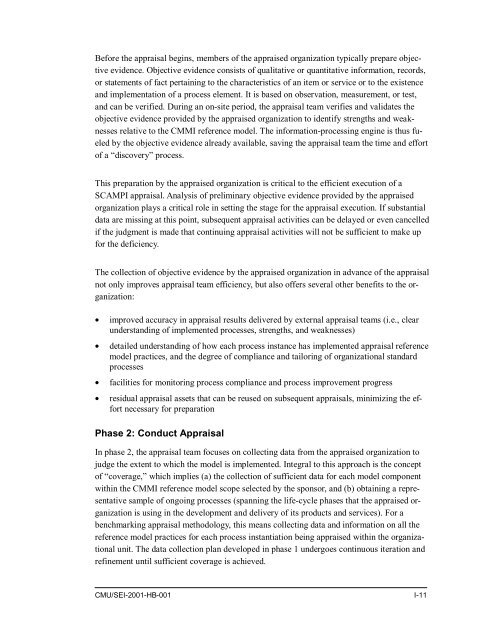Standard CMMI Appraisal Method for Process Improvement (SCAMPI)
Standard CMMI Appraisal Method for Process Improvement (SCAMPI)
Standard CMMI Appraisal Method for Process Improvement (SCAMPI)
Create successful ePaper yourself
Turn your PDF publications into a flip-book with our unique Google optimized e-Paper software.
Be<strong>for</strong>e the appraisal begins, members of the appraised organization typically prepare objective<br />
evidence. Objective evidence consists of qualitative or quantitative in<strong>for</strong>mation, records,<br />
or statements of fact pertaining to the characteristics of an item or service or to the existence<br />
and implementation of a process element. It is based on observation, measurement, or test,<br />
and can be verified. During an on-site period, the appraisal team verifies and validates the<br />
objective evidence provided by the appraised organization to identify strengths and weaknesses<br />
relative to the <strong>CMMI</strong> reference model. The in<strong>for</strong>mation-processing engine is thus fueled<br />
by the objective evidence already available, saving the appraisal team the time and ef<strong>for</strong>t<br />
of a “discovery” process.<br />
This preparation by the appraised organization is critical to the efficient execution of a<br />
<strong>SCAMPI</strong> appraisal. Analysis of preliminary objective evidence provided by the appraised<br />
organization plays a critical role in setting the stage <strong>for</strong> the appraisal execution. If substantial<br />
data are missing at this point, subsequent appraisal activities can be delayed or even cancelled<br />
if the judgment is made that continuing appraisal activities will not be sufficient to make up<br />
<strong>for</strong> the deficiency.<br />
The collection of objective evidence by the appraised organization in advance of the appraisal<br />
not only improves appraisal team efficiency, but also offers several other benefits to the organization:<br />
• improved accuracy in appraisal results delivered by external appraisal teams (i.e., clear<br />
understanding of implemented processes, strengths, and weaknesses)<br />
• detailed understanding of how each process instance has implemented appraisal reference<br />
model practices, and the degree of compliance and tailoring of organizational standard<br />
processes<br />
• facilities <strong>for</strong> monitoring process compliance and process improvement progress<br />
• residual appraisal assets that can be reused on subsequent appraisals, minimizing the ef<strong>for</strong>t<br />
necessary <strong>for</strong> preparation<br />
Phase 2: Conduct <strong>Appraisal</strong><br />
In phase 2, the appraisal team focuses on collecting data from the appraised organization to<br />
judge the extent to which the model is implemented. Integral to this approach is the concept<br />
of “coverage,” which implies (a) the collection of sufficient data <strong>for</strong> each model component<br />
within the <strong>CMMI</strong> reference model scope selected by the sponsor, and (b) obtaining a representative<br />
sample of ongoing processes (spanning the life-cycle phases that the appraised organization<br />
is using in the development and delivery of its products and services). For a<br />
benchmarking appraisal methodology, this means collecting data and in<strong>for</strong>mation on all the<br />
reference model practices <strong>for</strong> each process instantiation being appraised within the organizational<br />
unit. The data collection plan developed in phase 1 undergoes continuous iteration and<br />
refinement until sufficient coverage is achieved.<br />
CMU/SEI-2001-HB-001 I-11
















